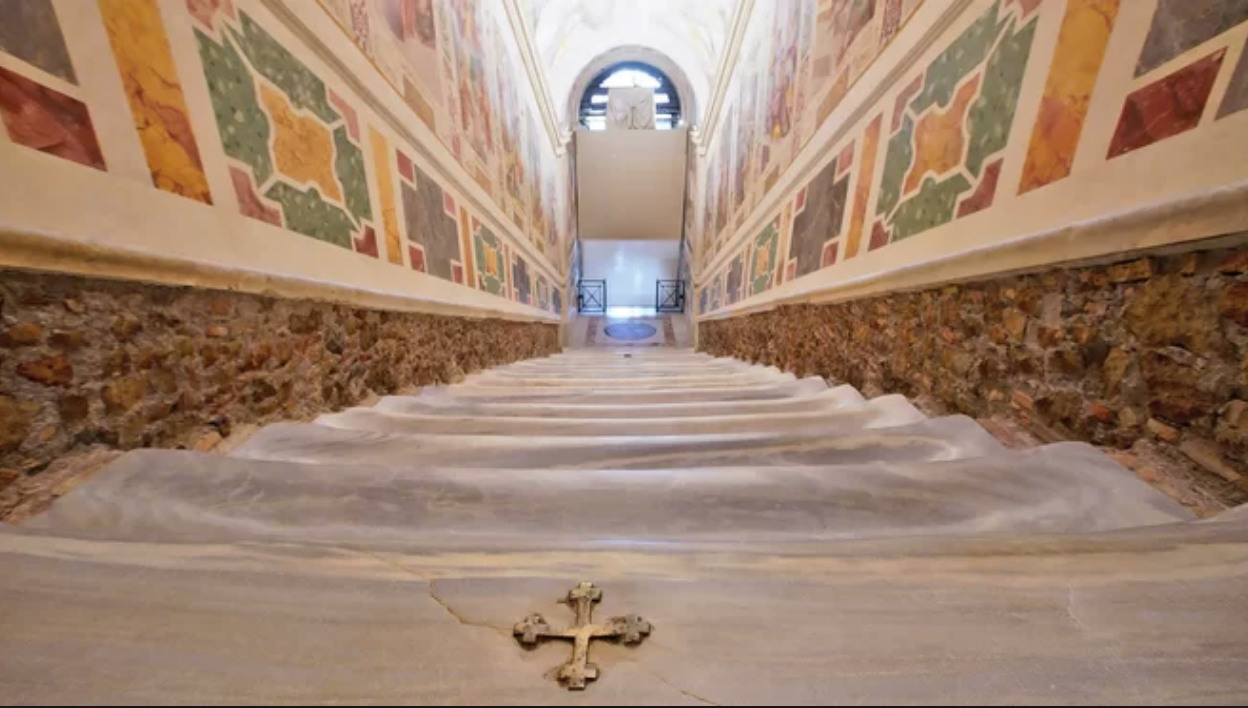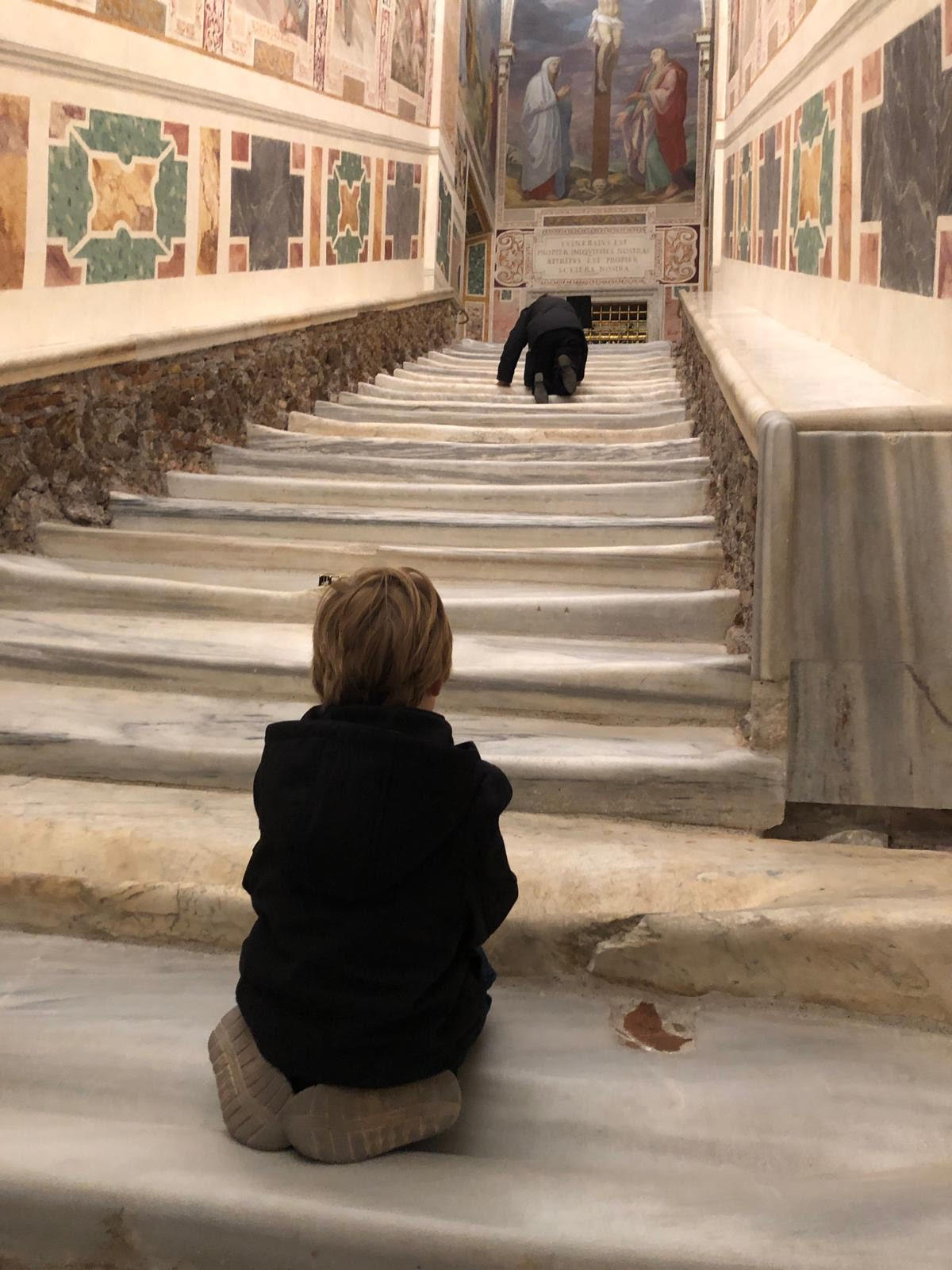Climbing the Scala Sancta in Rome
I went to the Scala Sancta with my son a few days ago and it was remarkable.

In case you didn't know, right now, there is a fantastic opportunity going on in Rome. The city’s famous pilgrimage destination, the Scala Sancta (“Holy Stairs”), are uncovered, and visitors can ascend the marble steps.
What's the big deal? For almost 300 years, the steps have been encased in planks of walnut wood, preventing faithful Catholics from touching the surface of the 28 marble steps some believe Jesus ascended before receiving his death sentence from Roman prefect Pontius Pilate.
A resident of Italy for two years now, I can say I get somewhat disappointed when something special to our Faith is covered up. I get it—curators and directors want to be sure the art or the artifact is not subject to deterioration or intentional damage. If you've seen just the basilica doors around Italy's best-visited locations, you understand that after thousands of thousands of hands rubbing the metal or wood or marble, it eventually smooths out and is lost to time.
With this in the back of my mind, I went to the Scala Sancta with my son a few days ago. A friend recently visited the Steps and informed me that if I want to have some amount of control over my pace, privacy and position on the Steps, I'd want to arrive at opening: 6 a.m. So I did. Four people were there when the door was quietly unlocked and opened.
It was pretty amazing to see the steps, and more importantly, to see their condition. Some were completely smoothed out while others had large chunks missing, which exposed the rock underneath. All of the steps, though, were concavely bowed in the middle, but the most extreme wear I saw almost baffled me. The front of each step was rounded like a large handrail, followed by a deep but smooth gouge in the middle or front portion of the step, and generally flat after that. I mean this—you could fit a baseball in some of these steps. They are incredibly worn. Look at this picture:

This deep imprint of innumerable pilgrims made, also, for a very painful climb on one’s knees. Speaking for myself at least, I found the entire experience painful: lifting myself from one misshapen step to the next, only to land on a step that was dissimilar from the last, requiring focus and consideration if intense pain was to be avoided. The ascent offered few instances of rest, either, since the rounded portions of the steps are where one would stop momentarily to say the choice prayer. If anything, moving slower than I needed could hurt more, and moving faster than necessary was exhausting and created sharp pains.
The entire thing was together an enjoyable penance and devotion.
The Scala Sancta brings more than pilgrims who are willing to bruise their knees—the claim of being the steps Christ ascended when he was condemned by Pilate bring skeptics, too. Two of the most famous skeptics are Martin Luther and Charles Dickens.
Martin Luther supposedly climbed the steps in 1510, on his knees as others still do. He said prayers on each step, believing that by doing this work one could benefit a soul purgatory. But when Luther arrived at the top he could not suppress his doubt, “Who knows whether this is true?”
Charles Dickens, after visiting the Scala Sancta in 1845, wrote: “I never, in my life, saw anything at once so ridiculous and so unpleasant as this sight.” He described the scene of pilgrims ascending the staircase on their knees as a “dangerous reliance on outward observances.”
Most skeptics will ask the obvious, non-theological question: Are these steps authentic?
The historians of the monument relate that the Holy Stairs were brought from Jerusalem to Rome about A.D. 326 by St. Helena, mother of Constantine the Great. In the Middle Ages, they were known as Scala Pilati, the Stairs of Pilate. Helena brought numerous relics, eventually including those of the True Cross, back to Rome, so it is consistent with her legacy that she ordered these steps to be brought back with her. From old plans it can be gathered that they led to a corridor of the Lateran Palace, near the Chapel of St. Sylvester, were covered with a special roof, and had at their sides other stairs for common use. The Lateran Palace was destroyed and rebuilt by Sixtus V (1589), but he ordered these steps to their present site in the palace and did not destroy that portion, being the private chapel of the popes and the gathering place of a vast collection of relics. Pilgrims continued to flock to the Steps and popes have given indulgences since then. Archeologists are objectively critical of the steps for not matching up with Jerusalem architectural features of the proper time.
Are they authentic? We can't know for sure. But here’s the way I see it: authentically walking in Christ's footsteps happens only when we authentically imitate Christ's love for others, humility and acceptance of suffering.
A funny thing happened—that also made me proud—when we first got in. My son was starting as at least two others were behind and in front of him. He mumbled something, and the man in front of him, gestured and said, “Shhhh.” Tristan, without hesitation, echoed throughout the narrow passage, “I just say two Hail Mary's on each step.” He’s 5 years old. And he didn't get another look after that.

I encourage you to see the Steps yourself if possible. We can't know for sure when the next time they will be uncovered, but it almost certainly will not be in our lifetime. If you can't get to Rome, don't worry! There are lovely replicas of the Scala Sancta in the Americas:
- Sanctuaire du Sacré-Coeur et de Saint-Padre-Pio in Montreal, Canada
- Saint Patrick — Saint Stanislaus Kostka in Pittsburgh, Pennsylvania
- The National Shrine of the Cross in the Woods in Indian River, Cheboygan County, Michigan
- Holy Family Chapel of the Congregation of the Sisters of Saint Joseph in Nazareth, Kalamazoo County, Michigan
My son, about 2 o'clock in the afternoon tugs my hand and says, “Dad, can we go climb the steps Jesus climbed?"”
“Tristan, we did that this morning.”
“Yeah. I just want to do it again tomorrow morning.”
And we did. The same four people were there at the opening, and although we didn’t speak with each other, we gave each other a peace-bearing smile.











